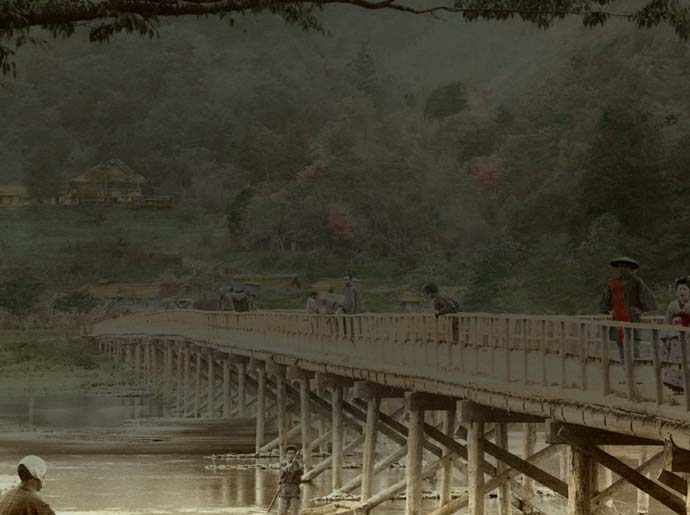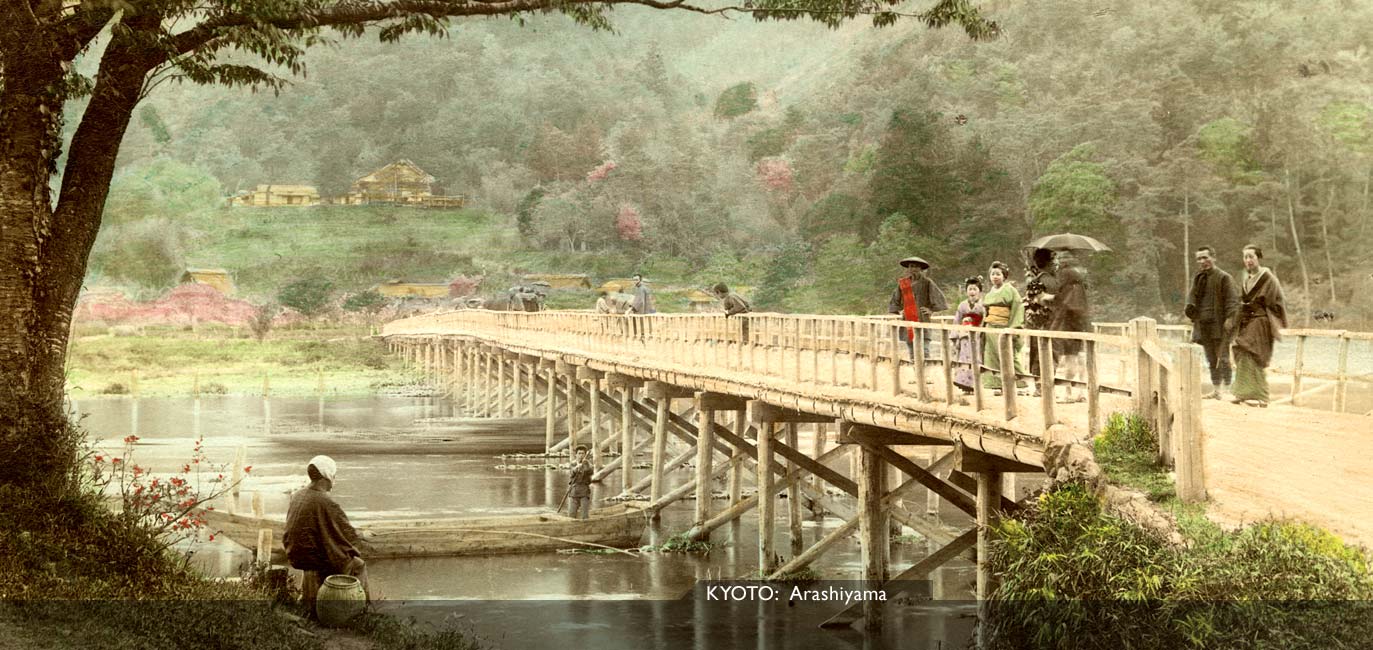
Kyoto—Sanjo bridge
“From the Shijo bridge to the Sanjo bridge Kioto’s riverbed is like a scene from fairy-land throughout the summer and during Gion matsuri the vision is enhanced. The tea-houses that line the river-bank with picturesquely galleried fronts set out acres of low platform tables in the clear shallow stream. The water ripples pleasantly around them, giving grateful sense of coolness to these aesthetic Japanese, who sit in groups on the open platforms, smoking their pipes and feasting under the light of their rows of lanterns.”

Kyoto—Rapid at Hozu and Arashiyama
“How can I describe the rush down the rapids? No time can be found to review the foliage and precipitous crags, but one’s whole attention is rivetted upon the surging waters, and upon the cool, steady boatmen, as with bamboo poles they ward us off from what seems inevitable destruction. For seven miles rapid follows rapid in quick succession, with an interval of clam water between each. Across the latter we are slowly poled or sculled, until a roar below and an impetus to the speed of the boat warns us to hold fast. The away we dash, quick as lightening, down the boiling torrent, sometimes apparently doomed to be smashed to pieces over a sullen black rock suddenly appearing in the track, but staved off at the last moment the long bamboo of the man at the bow, or more often by the recoil of the current itself.”
(
More)
Eliza Ruhamah Scidmore, Jinrikisha Days in Japan, (New York, 1891) p. 225
Arthur H. Crow, Highways and Byeways in Japan, (London, 1883) p. 244
Kyoto—Rapid at Hozu and Arashiyama
“The old barge began to dance a polka. It entirely forgot its age, and behaved in the most skittish manner. I groaned and it creaked, it plunged and it laboured, it flew to one side, then to another, it sprang forward, stopped, darted on again, while very plank streamed with foam as the long, dripping poles flashed out and the three muscular bodies did battle with the rocks. The coolness and skill of these men were wonderful. They seemed to know every rock personally. While waiting an obstacle they would stand motionless, keeping their balance in some marvelous way that came only of long and constant practice, the fine lines of their figures defined against the rushing water and dark cliffs. Then, when we were on the point of being hurled upon a rock, they would poise themselves, raise simultaneously a wild howl, place the slender poles with a swift, steady thrust, and strain until every muscle stood out and the bamboos bent like steel under the force of sinewy arms. The strange tattooing glinted from off the wet surface, the reds in particular catching the sunlight as the drip of the spray showers trickled down the naked skins.”
(
More)
Gilbert Watson, Three Rolling Stones in Japan, (London, 1904) pp. 142–143
Kyoto—Rapid at Hozu and Arashiyama
“Although all tourists spend a day in shooting the rapids of the Oigawa, it seems to me to be a waste of precious Kioto time and a performance out of harmony with the spirit of the place, although in May the blooming azaleas cause that wild an narrow canyon to blaze with color. The flat-bottomed boats dart through the seven-mile gorge as dash from one peril of shipwreck to another, just saved by a dexterous touch of the boatman’s poles, which fit into holes in the rocks that they themselves have worn. The flooring of the boats is so thin as to rise and fall with the pressure of the water, in a way that seems at first most alarming. The passage ends at Arashiyama, a steep hill clothed with pine, maple, and cherry-trees, which in cherry blossom time, or in autumn, is the great resort of all Kioto, whose pleasurings there form the theme of half the geisha’s songs and accompanying dances.”
Eliza Ruhamah Scidmore, Jinrikisha Days in Japan, (New York, 1891) p. 252
















gj10403



